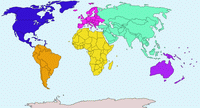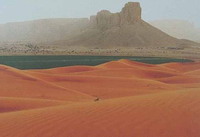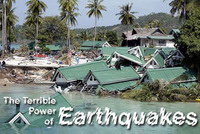Login form
Environment
Continents

You are probably on a continent right now. A continent is an enormous area of dry land on Earth. A continent is mostly surrounded by ocean. You can only see the ocean if you are on the edge of a continent. If you are not on a continent, then you might be on an island. An island is a smaller piece of land with water all around.
Deserts
 Do you think of a desert as a hot, dry place where sand stretches as far as you can see? The Sahara in North Africa is like that, but most deserts are not. All deserts are dry, but some deserts are very cold. Plants and animals live in most deserts. People have learned to live in deserts all over the world.
Do you think of a desert as a hot, dry place where sand stretches as far as you can see? The Sahara in North Africa is like that, but most deserts are not. All deserts are dry, but some deserts are very cold. Plants and animals live in most deserts. People have learned to live in deserts all over the world.
Most deserts form because of air movements over the planet. Masses of dry air create deserts. For example, deserts can form where air currents go over mountains. Water gets squeezed out of the air as it passes over the mountains, and a desert forms on the other side of the mountains.
Earthquakes
 What could be scarier than feeling the ground shake under your feet? Maybe this has happened if you live in a place that has earthquakes. The furniture shakes. Pictures drop from walls. Books fall off shelves. In really big quakes, roads can crumple up. Buildings and bridges can even collapse. And people can be killed.
What could be scarier than feeling the ground shake under your feet? Maybe this has happened if you live in a place that has earthquakes. The furniture shakes. Pictures drop from walls. Books fall off shelves. In really big quakes, roads can crumple up. Buildings and bridges can even collapse. And people can be killed.
WHAT CAUSES AN EARTHQUAKE?
Earthquakes are movements in Earth’s crust. The crust is Earth’s rocky outer layer, the solid ground that we live on. Earth’s crust is broken up into many gigantic sections of rigid rock called plates.
Diamonds
 They can cut metal. They can cut glass. They are billions of years old and form deep within Earth. Some are so rare and beautiful that people will pay a fortune to get one! They are diamonds.
They can cut metal. They can cut glass. They are billions of years old and form deep within Earth. Some are so rare and beautiful that people will pay a fortune to get one! They are diamonds.
WHAT ARE DIAMONDS?
Diamonds are made of carbon, a chemical element. That’s the same stuff that’s in the tip of a pencil. But isn’t carbon soft, not hard?
Pencil carbon is so soft that it rubs off on paper. But diamond carbon is so hard it can cut almost anything. In fact, diamonds are the hardest things in nature. What makes the difference? The atoms inside a diamond have a special crystal shape. This makes them very hard.
Erosion
 Why is river water sometimes brown? The water turns brown when it’s full of mud. A brown river is an example of erosion in action. Flowing water carries away, or erodes, tiny bits of dirt and rock from the ground it passes over. Erosion moves rock and dirt from place to place. Earth’s surface can be greatly changed by erosion. Over tremendously long periods of time, erosion can carry whole mountains into the sea!
Why is river water sometimes brown? The water turns brown when it’s full of mud. A brown river is an example of erosion in action. Flowing water carries away, or erodes, tiny bits of dirt and rock from the ground it passes over. Erosion moves rock and dirt from place to place. Earth’s surface can be greatly changed by erosion. Over tremendously long periods of time, erosion can carry whole mountains into the sea!
EROSION STARTS WITH WEATHERING
The dirt and pieces of rock that erosion carries away come from weathering. Weathering is the process by which nature breaks rocks up.
